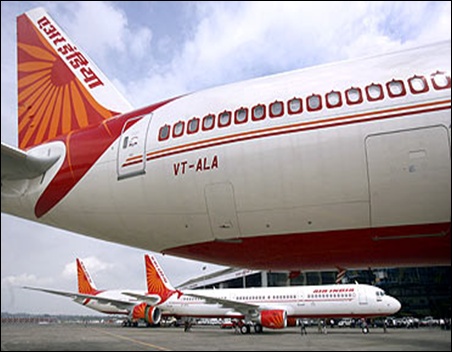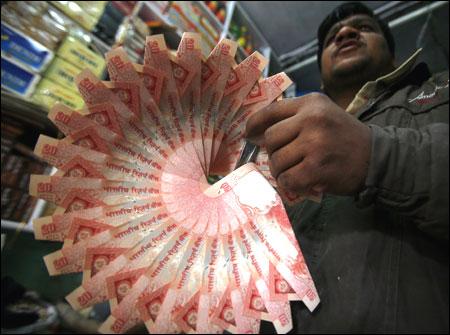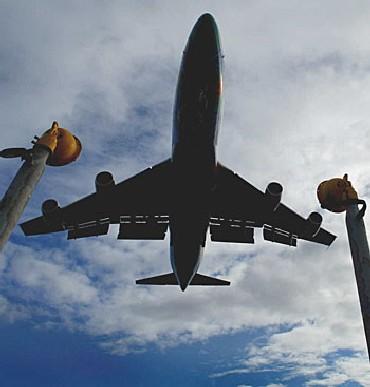Mihir Mishra and Aneesh Phadnis in New Delhi/Mumbai
Demand is outstripping supply in India's domestic air passenger market as airlines struggle with losses, debt and grounded aircraft.
Though India is one of the largest growing markets in terms of passenger volumes, airlines have not been able to add capacity to match growth.
Indian airlines increased capacity by three per cent since January 2011 in a market that grew by 17 per cent in most months of the year.
In January 2012, airlines together offered 210,000 seats per day on domestic routes, only three per cent up from 203,000 seats a year ago.
How demand-supply gap is ailing domestic aviation
In contrast, the air passenger market is up 12 per cent, with 181,514 people boarding an aircraft every day in January 2012, as against 162,066 last year.
Despite this growth, the sector has struggled with losses, and debt in the past year.
The combined losses of the three listed Indian carriers, Jet Airways, Kingfisher Airlines and SpiceJet, in the first half of FY 2011 touched Rs 1,878 crore (Rs 18.78 billion).
The airlines recently drew criticism from regulator DGCA for neglecting safety due to their financial constraints.
In such a scenario, growth planning seems to take a back seat.
. . .
How demand-supply gap is ailing domestic aviation
"We need to add at least around 15 per cent of the current industry strength of 400 aircraft per year to meet the growing demand," said a senior executive of a low-cost carrier, who did not want to be identified.
"Airlines added around 30 aircraft in the market in 2011 (but) one airline had to ground 20 aircraft."
The troubles of Kingfisher Airlines, which negotiated a Rs 1,600-crore (Rs 16-billion) bail-out with banks in early 2011 but still grounded 20 Airbus A320s in November, have been a big contributor to the demand-supply gap.
At 1,500 seats per A320 per day, the grounding took out roughly 30,000 seats per day from the market.
Market leader Jet Airways has struggled with losses, and added capacity mainly on international routes, leaving domestic routes largely untouched.
It will add planes this year to a fleet size of 101, but, again, these will fly foreign routes.
. . .
How demand-supply gap is ailing domestic aviation
Not going to get better
Morale in the industry is at a low, with some airlines forcing staff to take days off without pay or not paying them at all.
Analysts widely believe the ride is going to get rougher.
The Centre for Asia Pacific Aviation, a think-tank which tracks the sector, expects moderate airline growth in 2012 as operating costs continue to be high and prices fail to match costs.
"The next three to six months are critical for the aviation industry in India, as it will be facing its most critical phase in almost a decade.
"The cost environment will remain challenging. Fuel, depreciating rupee and airport charges will push the costs. Fares will remain soft," said CAPA head for the Indian sub-continent, Kapil Kaul.
. . .
How demand-supply gap is ailing domestic aviation
Many feel airlines are not focused on growing the sector to its potential.
"Instead of focusing on incentivising the passenger, who book early, the airlines are focusing on yields.
The growth can be fuelled by incentivising for early booking and charging more for last-moment bookings in a much more improvised way than now," said Keyur Joshi, co-founder and chief operating officer of Makemytrip.com, a Nasdaq-listed online travel portal.
"Also, fares should not be regulated and the market should be allowed to decide."
Airlines can press for improved infrastructure at various airports to grow the market.
"Major industrial towns like Ludhiana and Kanpur do not have proper air connectivity, barring a few flights through small aircraft," said Joshi.
. . .
How demand-supply gap is ailing domestic aviation
Low-cost
The capacity addition this year is likely to come from low-cost carriers.
LCCs, according to disclosed plans, will add 29 aircraft this year.
Of the 29, IndiGo will add 12, GoAir will add three, and SpiceJet will add four Boeing 737s and 10 Bombardier Q400s to boost regional connectivity.
Giorgio De Roni, chief executive officer of GoAir projects a weak phase for the airline industry.
"There was 18 per cent growth in November across the sector and average loads were 80 per cent.
"However, now we are entering Q4, which is a weak phase," he said.
. . .
How demand-supply gap is ailing domestic aviation
Air India and Jet Airways have no plans to add aircraft for domestic routes in 2012 and Kingfisher Airlines is reportedly downsizing fleet by around 30 per cent as it struggles to stay afloat.
"This year our domestic capacity will remain close to 2011. We are expecting five-seven per cent growth in traffic," a Jet Airways executive said.
The airline is expected to take out a couple of Boeing 737s from its subsidiary Jetlite's fleet as their lease agreements expire this year.
Both Jet and the national carrier will add aircraft on international routes.
. . .
How demand-supply gap is ailing domestic aviation
The government carrier plans to add Boeing 787 Dreamliners and is waiting for a decision from the government on them. Jet plans to add three Airbus 330s for international routes.
Aircraft maker Boeing, though, is upbeat. It predicts that airlines will add fleet, other than planned, to increase market share.
"Airlines will need to add planes, if they want to retain or increase market share.
"There will be capacity addition this year and apart from planned aircraft deliveries airlines will be taking planes on lease to retain and increase their market share," said Boeing India president Dinesh Keskar.









article